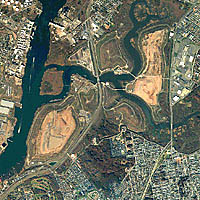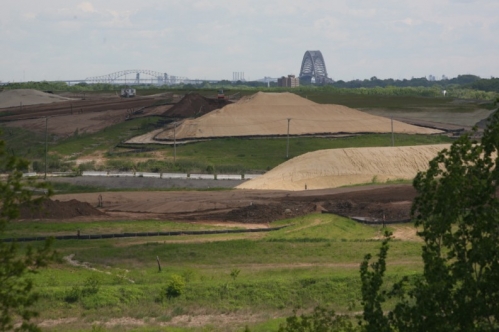I was shocked when I type in Silly Energy Uses into Google and got back 8 out of 10 references to Sarah Palin. But then I thought about it and realised that the Drill Here, Drill Now crowd does look silly, with oil prices in the 50$$ per barrel range and maybe going to 40$$ a barrel. The Saudis, the Ruskies and the Venezualans (should we call them Vennies?) have got to be looking to kill a bunch of Hedge Fund Operators and other bizzilionaires. Though the Brazilians (Brazzies?)got pletty of crap all over their faces too. What in the world are they going to do with all those oil rigs?
I have not had so much laughter and fun since the gas lines in the 70’s and the recession that led up to globalization in the 80s.
http://www.salon.com/tech/htww/2008/10/29/sarah_palin_on_energy/

Wednesday, Oct. 29, 2008 09:39 PDT
Sarah Palin’s silly energy speech
When the announcement that John McCain had chosen Sarah Palin to be his running mate broke across the political landscape like an Alaskan mountain avalanche, many analysts, including yours truly, jumped to the conclusion that her background in energy issues made her a savvy choice in an era of record-breaking oil prices. McCain’s “drill here, drill now” mantra was taking a bite out of Obama’s poll numbers, and the immediate expectation was that Palin would be a potent vehicle for delivering energy-related soundbites.
But it didn’t turn out that way. On Wednesday morning, oil traded at $65 dollars a barrel, more than 50 percent off its July peak of $147. The financial crisis proved more riveting than gas prices, and Sarah Palin’s rocky performance as a debutante on the national political stage swiftly obliterated the conventional wisdom that she could be an asset to the McCain campaign.
:}
But Palin’s speech is still worth some attention, because it clearly makes the case for why the McCain-Palin agenda is fundamentally wrong for the United States.
Palin started off by acknowledging that “the price of oil is declining largely because of the market’s expectation of a broad recession that would lower demand.” She was absolutely correct to note that “this is hardly a good sign of things to come,” and that “when our economy recovers, and growth once again creates new demand, we could run into the same brick wall of rising oil and gasoline prices.”
(:=} even the Saudis got to get into the act)
http://online.wsj.com/article/SB122523334615277739.html
LONDON — The slump in oil prices has spread relief among consumers and fuel-reliant industries, but also is squeezing the companies who could invest in new sources of oil — spurring concerns that prices will prompt them to shelve investments.
Industry executives warn that could mean the world will face a dramatic ramping up of prices as soon as the global economy, and demand, begins to rebound.
“Low oil prices are very dangerous for the world economy,” said Mohamed Bin Dhaen Al Hamli, the United Arab Emirates’ energy minister, speaking Tuesday at an oil-industry conference in London.
(:=}
The piece drew many comments but the first is the most rational. Then they decay into the IT CAN’T BE DONE comments from the ignorant right. As usual.
http://letters.salon.com/tech/htww/2008/10/29/sarah_palin_on_energy/view/index3.html?show=all
What we need is a commitment to relatively low-tech alternative energy
Solar satellites and fusion energy are pie-in-the-sky ideas that have been around forever and have yielded little practical promise. Existing earth-based solar collector and wind farm technology could provide a substantial percentage of our energy needs right now. Dedicating a few hundred square miles of CA/NV desert land to a massive solar collector that could provide 100% of U.S. electrical needs would be a worthy investment.
http://www.gossiprocks.com/forum/u-s-politics-issues/86951-sarah-palins-silly-energy-speech.html
Both the McCain/Palin campaign and the Obama/Biden campaign are making unrealistic promises about the prospect of reaching energy independence. As Obama himself notes, when you consume 25 percent of the world’s oil but own only 3 percent of the world’s oil reserves, energy independence isn’t ever going to come from expanding domestic production.The difference between the two campaigns is that McCain/Palin is more unrealistic. Obama has made it clear that his energy independence plan will requires massive expansion of alternative and renewable energy resources and huge investments in conservation and energy efficiency, even as he acknowledges that more investment in offshore drilling, nuclear power, and clean coal will also most likely be necessary. (McCain and Palin routinely misrepresent Obama’s position on nuclear power and clean coal, and the vice presidential candidate did so again today.)Palin devoted one paragraph of her energy security policy speech to alternative energy solutions.
In our administration, that will mean harnessing alternative sources of energy, like wind and solar. We will end subsidies and tariffs that drive prices up, and provide tax credits indexed to low automobile carbon emissions. We will encourage Americans to be part of the solution by taking steps in their everyday lives that conserve more and use less. And we will control greenhouse gas emissions by giving American businesses new incentives and new rewards to seek, instead of just giving them new taxes to pay and new orders to follow.
That’s not enough. True leadership on energy requires devoting more than one paragraph to vague handwaving about wind and solar and greenhouse gas emissions. Economic turmoil and low oil prices may have shunted renewables and conservation off the main track for now, but to quote Palin, “this is hardly a sign of good things to come.”
:}
But then the real waste of Energy was people trying to “figure out the real” John McCain. He was the guy who wanted to build 100 NUKES and was too old and out of touch to be President.
http://sillyhumans.blogspot.com/
By TIM DICKINSON Posted Oct 16, 2008 7:00 PM
—
This is the story of the real John McCain, the one who has been hiding in plain sight. It is the story of a man who has consistently put his own advancement above all else, a man willing to say and do anything to achieve his ultimate ambition: to become commander in chief, ascending to the one position that would finally enable him to outrank his four-star father and grandfather.
In its broad strokes, McCain’s life story is oddly similar to that of the current occupant of the White House. John Sidney McCain III and George Walker Bush both represent the third generation of American dynasties. Both were born into positions of privilege against which they rebelled into mediocrity. Both developed an uncanny social intelligence that allowed them to skate by with a minimum of mental exertion. Both struggled with booze and loutish behavior. At each step, with the aid of their fathers’ powerful friends, both failed upward. And both shed their skins as Episcopalian members of the Washington elite to build political careers as self-styled, ranch-inhabiting Westerners who pray to Jesus in their wives’ evangelical churches.
http://www.rollingstone.com/news/coverstory/make_believe_maverick_the_real_john_mccain
On the grounds between the two brick colleges, the chitchat between the scion of four-star admirals and the son of a prizefighter turns to their academic travels; both colleges sponsor a trip abroad for young officers to network with military and political leaders in a distant corner of the globe.
“I’m going to the Middle East,” Dramesi says. “Turkey, Kuwait, Lebanon, Iran.”
“Why are you going to the Middle East?” McCain asks, dismissively.
“It’s a place we’re probably going to have some problems,” Dramesi says.
“Why? Where are you going to, John?”
“Oh, I’m going to Rio.”
“What the hell are you going to Rio for?”
McCain, a married father of three, shrugs.
“I got a better chance of getting laid.”
:}
:}








